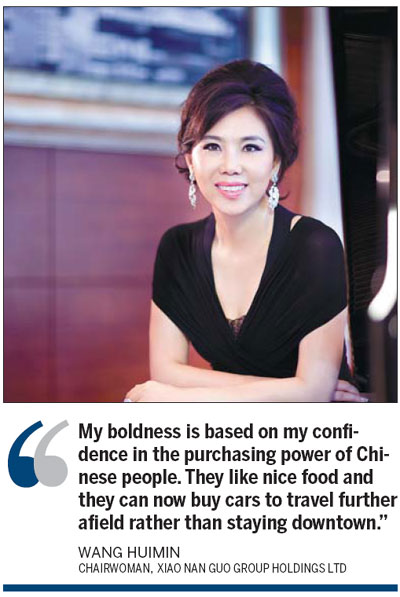
Her new 1,000-plus sq m restaurant soon became an essential diner for business travelers to Shanghai after its launch in 1997. They could taste authentic local food, enjoy a decent environment while being close to a major transport hub.
Wang's boldest investment on the mainland was 100 million yuan in 2000 when she bought a 1.3 hectare property to build a flagship restaurant with the capacity to seat nearly 1,000 people in a Shanghai suburb. Although some people doubted whether customers could afford to travel so far to enjoy food, the move proved a success.
"My boldness is based on my confidence in the purchasing power of Chinese people," said Wang. "They like nice food and they can now buy cars to travel further afield rather than staying downtown."
The nation's dining industry has maintained double-digit growth over the past 30 years. Revenues topped 2 trillion yuan in 2011. They are expected to reach 3.7 trillion yuan by the end of 2015, according to the Ministry of Commerce.
Xiao Nan Guo is now operating more than 70 restaurants in 10 provinces and the Hong Kong Special Administrative Region. Wang plans to have 100 outlets on the Chinese mainland, Hong Kong and Macao by 2013.
Xiao Nan Guo opened its first Hong Kong chain in 2001. Choosing Hong Kong as the second regional focus of Xiao Nan Guo outside Shanghai, Wang admitted that the move was bold and said that she took the risk of losing money to gain experience.
"I wanted to see a wider view of the world by bringing my restaurant to Hong Kong to learn how to survive in a place with a wide range of food from all over the world," said Wang.
Eleven years later, Wang's decision proved to be wise after Xiao Nan Guo was listed on the Hong Kong Stock Exchange on July 4, 2012, raising HK$512 million ($66.03 million).
After running the business for many years, Wang started thinking of introducing a professional and young management team to regulate and expand the group.
Kang Jie, the current chief executive officer, was the suitable person Wang discovered who could lead the core management.
Before joining the group in 2010, Kang worked at Bear Stearns & Co Inc, a global investment bank and securities trading and brokerage firm until its sale to JPMorgan Chase in 2008.
Two years after being put in charge of the restaurant and being equipped with a team of professionals, Kang's task is to speed up the expansion of Xiao Nan Guo as a chain restaurant with a standardized operational system.
In 2011, 22 new restaurants were opened, 13 more than the number of the company's newly launched restaurants in 2010. "We are ready to standardize the quality of food by having six central kitchens and five central warehouses all over the country to ensure consistent quality and efficiency," said Kang.
The cuisine company is adopting multi-brand strategy. Apart from Xiao Nan Guo restaurants, the group also serves business and high-end clientele under the brand Maison De L'Hui, offering Cantonese and Shanghainese cuisines, and the Dining Room, which serves Shanghainese cuisine in a stylish casual setting aimed at attracting white-collar workers.
Kang added that Xiao Nan Guo wants to attract more private rather than business diners in the near future, and the other two outlets will attract 50 percent of the group's customers.
Xu Juanjuan, an analyst at Guotai Junan Securities, said that despite the downturn in China's dining industry, hit by rising costs and slowing economic growth, the market for mid- and high-end dining is still huge.
yuran@chinadaily.com.cn


 'Cat model' to dazzle Shanghai auto show 2013
'Cat model' to dazzle Shanghai auto show 2013
 Models at Tokyo modified car show
Models at Tokyo modified car show
 Shanghai Fashion Week focuses on domestic brands
Shanghai Fashion Week focuses on domestic brands
 Angel-dress models at Shandong auto show
Angel-dress models at Shandong auto show
 Safe and Sound
Safe and Sound
 Theater firms scramble for managers
Theater firms scramble for managers
 Premier pledges closer ties with Brunei
Premier pledges closer ties with Brunei
 Volkswagen's all-new GTI at New York auto show
Volkswagen's all-new GTI at New York auto show